Chapter 9: Political Organization of Space
9.6 Cooperation between States
Supranational Organizations
In order to provide shared military and economic security as a unified entity, states engage in alliances. Military alliances help protect states from common enemies, and economic alliances allow for the free exchange of goods in a larger market. These alliances are also referred to as supranational organizations, and they all involve states giving up some of their sovereign power for the common good.
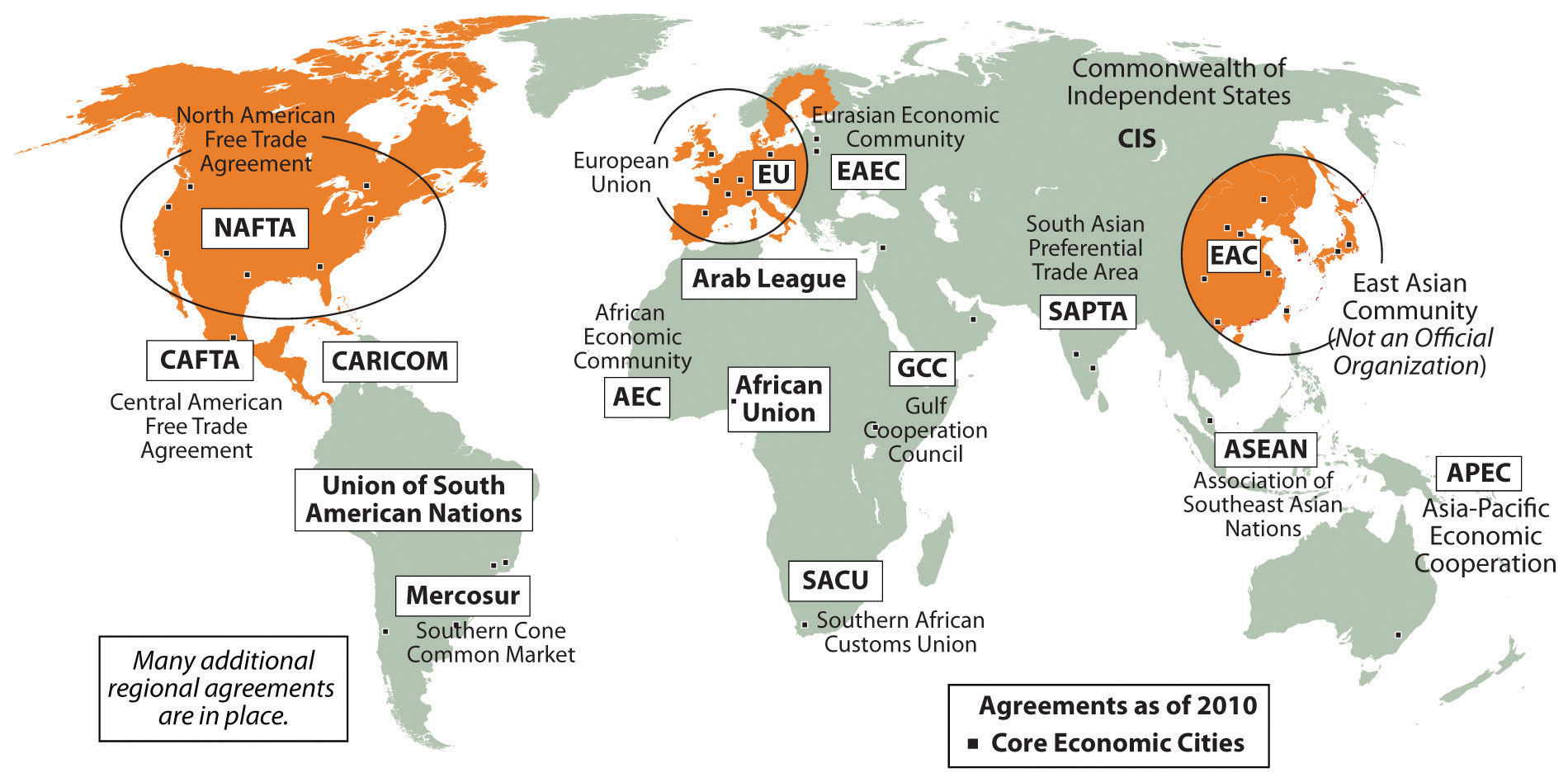
Source: “Figure 2.15 Global Groups with the Big Three Core Areas of North America, Western Europe, and Eastern Asia” by Dr. Royal Berglee, CC BY-NC-SA 3.0.
9.6.1 The United Nations (UN)
The United Nations is the largest supranational organization in the world. The UN stands as a cornerstone of international cooperation and diplomacy, comprising 193 member states committed to addressing global challenges through dialogue, negotiation, and collective action. Established in 1945 in the aftermath of World War II, the UN serves as a platform for nations to come together and discuss matters of peace, security, development, human rights, and international law. One powerful example of its function as a supranational alliance is the UN Peacekeeping Operations. These missions deploy troops and personnel from various member states to conflict zones around the world, aiming to maintain peace, protect civilians, and facilitate political processes. This collective effort not only demonstrates the UN’s commitment to global stability but also showcases its ability to leverage diverse national capabilities in pursuit of common goals, transcending individual national interests for the greater good of humanity.
The UN comprises several prominent entities that play crucial roles in its mission to promote peace, security, human rights, and sustainable development globally. Some of the most well-known entities include the Security Council that is responsible for maintaining international peace and security. This Council has primary responsibility for peacekeeping operations and can impose sanctions or authorize the use of force. It also includes the International Court of Justic ethat settles legal disputes between states and gives advisory opinions on legal questions referred by UN organs and specialized agencies. The World Health Organization (WHO) is also part of the UN.
The headquarters of the UN is in New York City, and important subsidiary organizations of the UN include the World Health Organization (WHO), UNESCO (United Nations Educational, Cultural and Cultural Organization) and the Food and Agriculture Organization (FAO).
9.6.2 Military Alliances – NATO and Warsaw Pact
The North Atlantic Treaty Organization (NATO) comprises 32 states and was developed after World War II to counter the threat of the former Soviet Union. Member states include 30 Western European states (the latest new members were Sweden and Finland) as well as the United States and Canada
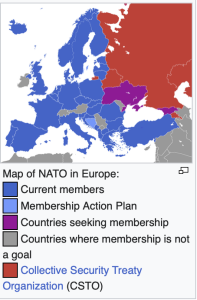
Source: “NATO 32 Members” by Hasancelikbilek35 via Wikimedia Commons is licensed under CC BY-SA 4.0.
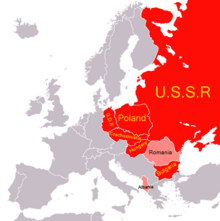
Source: “Eastern bloc” from Wikimedia Commons is licensed under CC BY-SA 3.0.
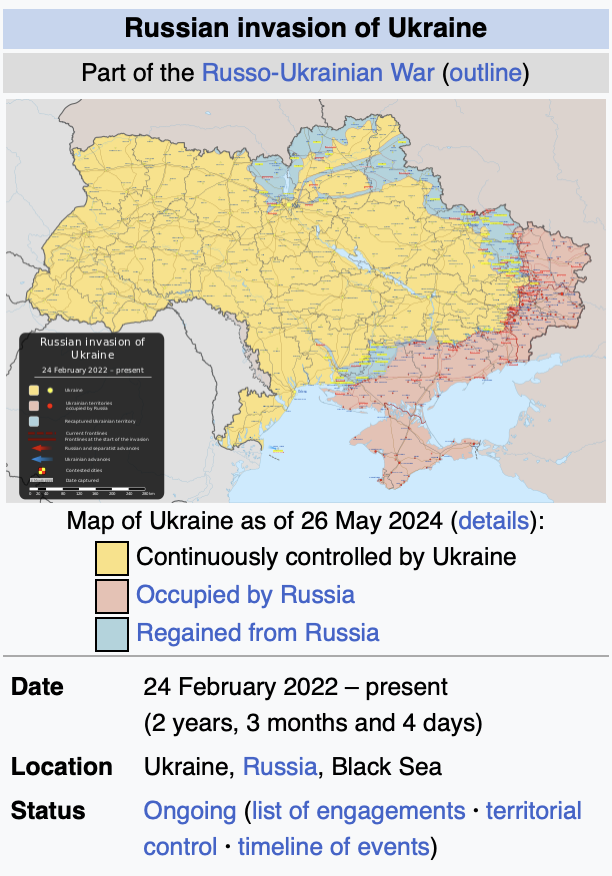
Source: “2022 Russian invasion of Ukraine” by Viewsridge via Wikimedia Commons is licensed under CC BY-SA 4.0.
When the Soviet Union existed, the Warsaw Pact was a military alliance between the Soviet Union and seven satellite states of Eastern and Central Europe (Figure 9.6.2). The Warsaw Pact disbanded in 1991, and several of the former Soviet states as well as satellite states have subsequently joined NATO. As a result, Russia has felt isolated and vulnerable, and as a result, has been aggressively acting to seize or control territories in states close to its borders. For example, in 2008, Russia engaged in a military conflict in Georgia, one of the former Soviet states, in order to support a separatist movement allied with Russia. In 2014, Russia invaded the peninsula of Crimea, within the territorial boundaries of Ukraine, one of the former states in the Soviet Union. Furthermore, Russia has intervened militarily against the rebel forces fighting in eastern Ukraine. Then, in Feb 2022, Russia invaded Ukraine with full force and has been battling the country since. Russia met with unanticipated severe resistance and at this point cannot pull out of this war without losing face.
9.6.3 Military Alliances – Terrorism
Although terrorists are characterized as non-military, non-state actors, they have a tremendous impact on states around the world and involve allied groups in many countries. Terrorism is the intimidation of a population by violence in order to further political aims. Terrorism is proving to be an enduring global threat, because modern terrorist groups have become more lethal, networked and technologically savvy. Today, groups such as ISIL and al-Qa’ida can control land and hold entire cities hostage. This power mainly stems from their ability to generate revenue from numerous criminal activities with almost complete impunity.
During the time of the 11 September 2001 attacks on the World Trade Center and the Pentagon, al-Qa’ida numbered around 300 mujahedeen in Afghanistan with the support of the Taliban. Fifteen years later, two global terrorist groups have emerged transforming the global threat landscape — al-Qa’ida and the Islamic State in the Levant (ISIL). At the end of 2015 ISIL controlled 6-8 million people in an area the size of Belgium, and maintained a force of between 30,000- 50,000 fighters while attracting the greatest number of foreign fighters in history.
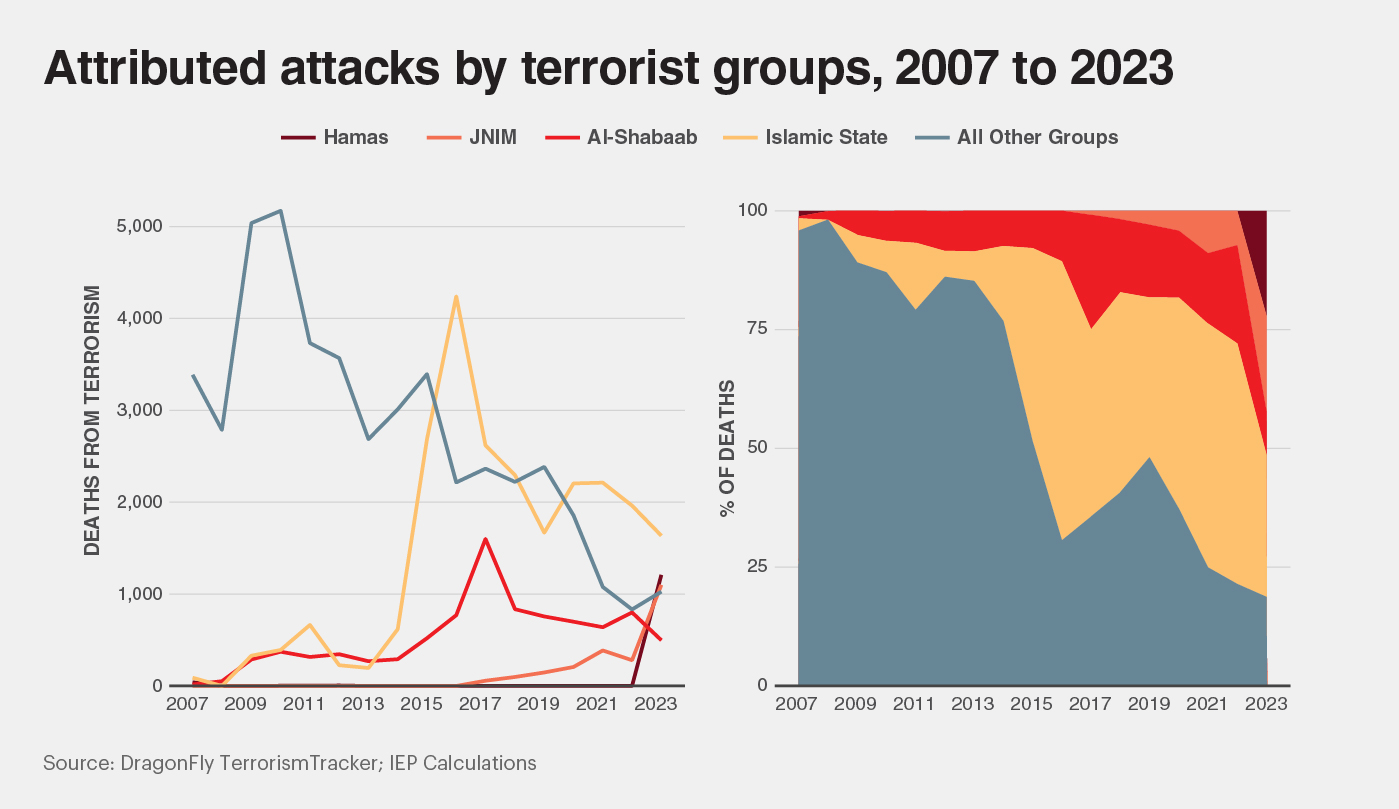
Source: “Attributed attacks by terrorist groups, 2007 to 2023” by Vision of Humanity.
States worldwide are being challenged by criminal-terrorist networks; especially in prisons, urban areas, and cyberspace. Prisons have become the place where terrorists and criminals meet, plan, plot, and recruit. The most prominent example is Abu-Bakhr al- Baghdadi, the leader, and self- declared caliph of ISIL, who spent formative time at Camp Bucca, a US-controlled prison in Iraq. This is where he met Samir Abd Muhammad al-Khlifawi, a former colonel in the intelligence service of Saddam Hussein’s air defence forces, and who was the architect of the ISIL strategy for the takeover of towns, focusing heavily on surveillance and espionage. The Iraqi government estimates that 17 of the 25 most important ISIL leaders spent time in US prisons in Iraq, planning the creation of ISIL and its ideology.
In the West, prisons have also become a networking and learning environment where terrorists and criminals can share ideology and build networks. A large percentage of terrorist recruits – some estimates are as high as 80 percent – have criminal records varying from petty to serious crimes. The recruitment of criminals provides terrorists with the skill sets needed to succeed: a propensity to carry out violent acts, ability to act discreetly, and access to criminal markets for weapons, and bomb-building resources. A study on extremists who plotted attacks in Western Europe found that 90 percent of the cells were involved in income-generating criminal activities and half were entirely self-financed: only one in four received funding from international terrorist organizations.
9.6.4 Major Terrorist Organizations
9.6.4.1 Al-Qaeda
This is a global militant organization founded in 1988 by Osama bin Laden and other extremist leaders, gained worldwide notoriety for its involvement in numerous terrorist attacks. Among its most infamous acts was the September 11, 2001, attacks on the United States, which killed thousands and prompted a global crackdown on terrorism. Beyond 9/11, Al-Qaeda orchestrated or inspired attacks in various regions, including the 1998 bombings of U.S. embassies in East Africa and the 2002 bombings in Bali. Its modus operandi often involved suicide bombings, coordinated strikes against Western interests, and efforts to destabilize governments seen as cooperating with Western powers. Over time, Al-Qaeda’s decentralized structure allowed it to operate through regional affiliates and sympathizers, further complicating global efforts to eradicate its influence.
While terrorists have created insecurity in the ‘real’ world for decades, there has been a major paradigm shift for the last 15 years: terrorists are now engaged in the world’s greatest open space, the internet. ISIL’s growing global influence marks the first time in history that a terrorist group has held sway in both the real and virtual worlds. Maybe one of the most important developments is the increasing collaboration of criminal and terrorist networks. While criminals used to focus only on revenue generation and terrorists were driven by political motives, we are currently witnessing a convergence of terrorism and crime. These new hybrid groups are driven by both, revenue generation and political motives, resulting in criminal and terrorist groups with historically unprecedented resources and transgressive aims. The consequence of this expanding threat can be measured by the way in which both al-Qa’ida and ISIL have increased their sphere of influence worldwide.
One way to counter such terror activities is to increase vigilance. To this effect, the Global Terrorism Index (GTI) provides extensive analyses that assess the terrorism impact across 163 countries, encompassing 99.7% of the global population.
Produced by the Institute for Economics & Peace (IEP), the GTI utilizes data from the Terrorism Tracker and other sources. It generates a composite score to rank countries in terms of their susceptibility to terrorism. Scores range from 0 to 10, where 0 indicates no terrorism impact and 10 signifies the highest measurable impact. Check the map in the link; it is quite impressive!
Given the substantial investments governments worldwide make in counter-terrorism efforts, it is crucial to aggregate and analyze available data to comprehensively understand its characteristics. One of GTI’s primary objectives is to scrutinize these trends and foster constructive discussions regarding terrorism’s future and the necessary policy responses.
9.6.5 Economic Alliances – EU – NAFTA – ASEAN
One of the most prominent economic alliances in the world is the European Union (EU), which consists of 27 member states (Figure 9.15). What began as the European Community (EC) in 1958, the European Union has grown significantly from the original six members and now includes seven Eastern European states that were formerly in the Soviet Union.

Source: Map by Evan Centanni, from blank map by Ssolbergj. License: CC BY-SA
The EU has developed a common currency, the euro, for all member countries and a European Central Bank. Furthermore, at most boundaries, a passport is not required to enter another country.
The European Union recognizes 24 official languages and offers simultaneous translation among the official languages to any member state that requests it. The EU only produces legislation and policy documents of “major public importance” in all of its official languages; other documents are translated only into the languages relevant to each document.
Translation is just one of the significant expenditures associated with integration. Under the rules of the EU, the richer countries must subsidize (provide financial support to) the poorer ones; therefore, the entry of eastern European states adds to the financial burden on the wealthier western and northern European members. A major economic downturn at the end of the first decade of the twenty-first century and associated financial crises in Greece, Ireland, Spain, and Portugal, put the EU under unprecedented pressure. The citizens of wealthier countries such as Germany began to question why they should foot the bill for countries that have not (at least in German eyes) managed their finances responsibly.
Another issue confronting the EU is whether or not to allow Turkey to join, as Greece has long-standing disputes with Turkey over territory in Cyprus, and the Turkish central government has been accused of anti-democratic practices, particularly in treating its largest minority group-the Kurds.
An important economic alliance for the United States is the North American Free Trade Agreement (NAFTA). Established in 1992, this alliance integrates the United States, Mexico and Canada and facilitates the flow of goods and services across borders. The Trump administration has repeatedly criticized this agreement, as manufacturers have relocated production to Mexico which has resulted in the loss of manufacturing jobs in America. Whether or not the United States withdraws from NAFTA or simply renegotiates the agreement remains to be seen.

Suorce: “Map of ASEAN member states,” derivative work: Hariboneagle927 is in the public domain.
Another significant alliance is the Association of Southeast Asian Nations (ASEAN), a regional intergovernmental organization comprising ten member states: Brunei, Cambodia, Indonesia, Laos, Malaysia, Myanmar, the Philippines, Singapore, Thailand, and Vietnam. Established on August 8, 1967, ASEAN aims to promote economic growth, social progress, cultural development, and regional stability among its members. The union serves as a platform for cooperation on political, economic, social, and cultural issues, fostering dialogue and collaboration through various mechanisms such as the ASEAN Summit and ASEAN Ministerial Meetings. Economically, ASEAN facilitates trade and investment through initiatives like the ASEAN Free Trade Area (AFTA) and enhances connectivity through projects like the ASEAN Infrastructure Fund. Politically, it promotes regional stability and conflict resolution through its mechanisms and dialogues. Socially, ASEAN promotes people-to-people exchanges and cooperation in areas such as education, healthcare, and disaster management. Overall, ASEAN plays a crucial role in enhancing regional integration, cooperation, and collective security, benefiting its member states and contributing to peace and prosperity in Southeast Asia and beyond.
9.6.6 Environmental Alliances – IPPC
The Intergovernmental Panel on Climate Change (IPCC) is the United Nations body for assessing the science related to climate change. The IPCC compiles thorough Assessment Reports detailing scientific, technical, and socio-economic insights into climate change, its impacts, future risks, and strategies to mitigate its progression. Additionally, it develops Special Reports focusing on subjects prioritized by member governments, along with Methodology Reports that offer guidelines for constructing greenhouse gas inventories.

Source: The Working Groups and Task Force of The Intergovernmental Panel on Climate Change (IPCC).
The IPCC was established to provide policymakers with periodic scientific evaluations on climate change, its consequences, prospective risks, and proposals for adaptation and mitigation measures. It identifies where there is agreement in the scientific community on topics related to climate change, and where further research is needed. The reports are drafted and reviewed in several stages, thus guaranteeing objectivity and transparency. The IPCC does not conduct its own research.

